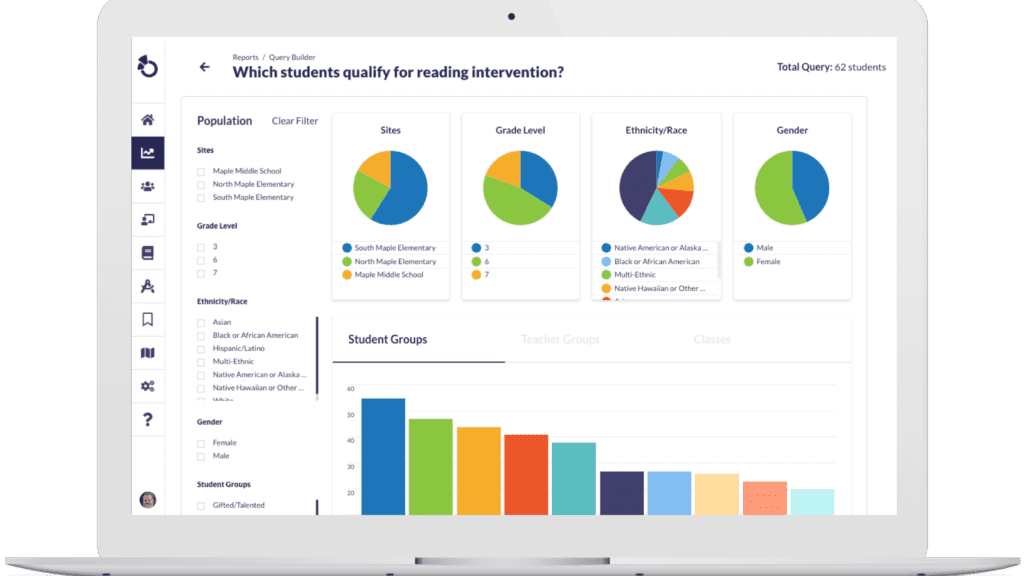Bridges in Mathematics + Otus: Flexible Approaches, Meaningful Impact
By: Kendell Hunter
During a recent webinar, math interventionists Sarah Compton and Emily McGee from Monroe School District shared how their district uses Bridges in Mathematics and Otus to strengthen math instruction and student learning.
The discussion explored:
- How Monroe maintained fidelity to Bridges assessments while adapting them to fit their rubric-based grading model in Otus
- How PLCs use real-time data from Otus to guide instruction and intervention
- How students and families gain visibility into progress through shared goals and standards-aligned rubrics
Together, these approaches show how the right combination of curriculum and technology can help schools turn data into action.
Watch the webinar:
3 insights from Monroe School District’s use of Bridges in Otus
1. Flexibility meets fidelity
The best tools don’t ask teachers to choose between consistency and creativity, and Bridges in Otus is a perfect example. When Monroe School District adopted Bridges and Otus, they wanted to balance structure with teacher choice. The district implemented the full fidelity of Bridges assessments while adapting them to fit their rubric-based scoring model in Otus, making data entry more efficient without losing alignment to standards.
Teachers can deliver assessments digitally or on paper, with all results captured in one view. The flexibility ensures math data remains meaningful for every audience, from classrooms to administrators.
“One of the key advantages for us was having those Bridges assessments already available in Otus. We created district rubrics, grouping together related assessment questions under the same standard to produce a single score. This model worked really well for us because it made the data entry more efficient for teachers, and as a PLC district, we had already identified those power standards or those essential outcomes that guide our priority work. So our Bridges Rubrics and Otus were designed to reflect our district priorities. I think this really speaks to the flexibility within Otus to make systems that work for your district in your circumstance.”
Sarah Compton
Math Interventionist
,
School District of Monroe (WI)
2. Turning data into dialogue
When Bridges assessments live in Otus, collaboration becomes second nature. Teachers, interventionists, and administrators can access real-time results that paint a shared picture of student understanding, whether it’s pinpointing where fractions are breaking down or spotting growth in number sense over time.
For Monroe, using Bridges in Otus totally changed how teams collaborate. Teachers, interventionists, and administrators now access real-time analytics that show which skills need reteaching and which students are ready to move ahead. Instead of spending hours compiling data, PLCs arrive ready to plan instruction. This shared view of student progress fosters stronger alignment between grade levels and buildings.
“We are a PLC district, meaning we discuss the data collaboratively, but each teacher takes a slightly different approach in their response. We have one educator who saw a classroom need and used their intervention time to review the whole group. Another class may have had a small group of students who had a major misconception in their computation work. She had to work with them while the remainder of the class was doing concept quests or practice pages. We know that teaching is a science and an art, and we certainly don't micromanage that intervention time or how teachers are responding to what we input into Otus. In the end, the data really serves as our accountability measure.”
Sarah Compton
Math Interventionist
,
School District of Monroe (WI)
3. Empowering students through visibility and voice
Real engagement in math happens when students understand why they’re learning, not just what they’re learning—and Bridges in Otus helps make that connection visible. Teachers at Monroe use color-coded rubrics, goal-setting tools, and digital progress tracking to help students visualize their growth, and as a result, students are showing meaningful progress in understanding their own learning.
Students can log into Otus to view their results, set goals for upcoming units, and monitor their progress toward key standards. Families can also see this information in real time, making it easier to celebrate growth and have informed conversations at home. The outcome is a classroom culture where students feel ownership over their learning and understand how their daily work connects to long-term success.
“As a part of the partnership with Otus, what we've really focused on the last two years as a district is student and teacher goal setting. The use of Otus with Bridges has really allowed us to focus on standard by standard, target by target. Students are much more familiar with what the expectations are for them to learn that unit and what those power standards or those essential outcomes that we've identified for the year for them are, and those are what we're putting in those rubrics in Otus. So they're very aware of those, and then they're setting goals within their classroom for those different areas that they choose.”
Emily McGee
Math Interventionist
,
School District of Monroe (WI)

Kendell Hunter
Director of Marketing
Otus
Kendell Hunter is a former special education teacher and reading specialist with a master’s degree in education and more than a decade of experience in K-12 schools and edtech.
Related Resources
Request a demo!
See exactly how Otus can help your school accelerate student growth and improve student outcomes – all while saving educators time.




